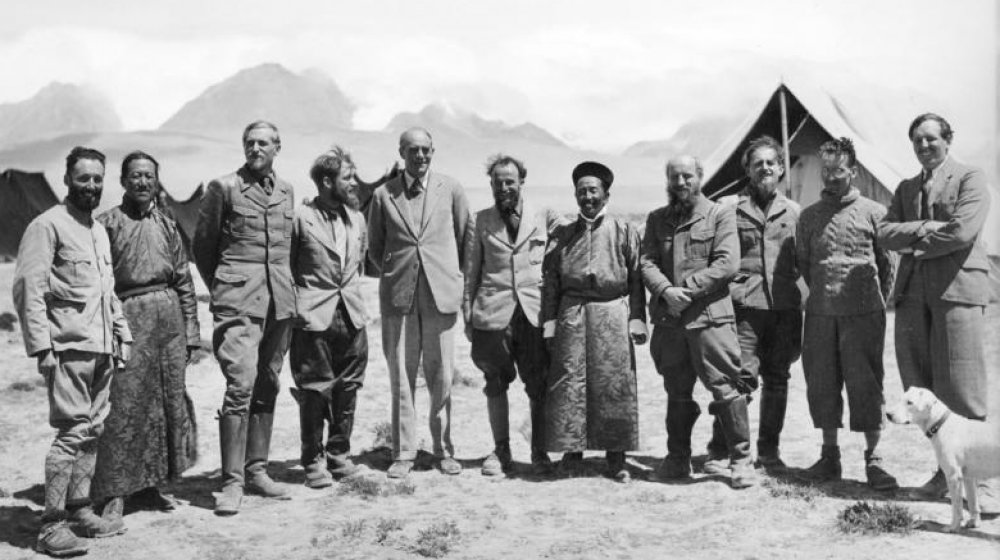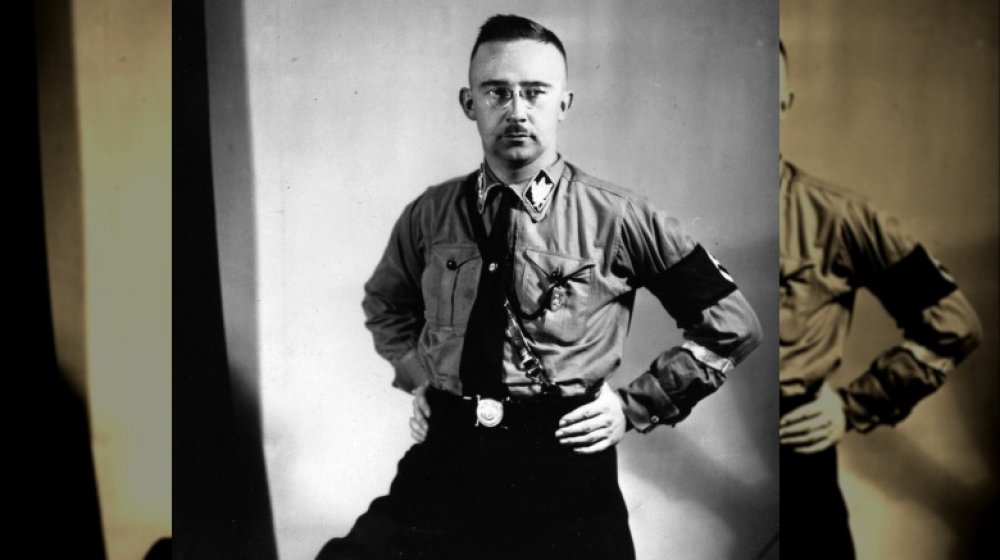The Untold Truth Of The Ahnenerbe: Hitler's Archaeologists
There's a lot of words that can be used to describe Adolf Hitler and Heinrich Himmler, and among the ones that are repeatable in polite company are things like "obsessive," "weird," and "convinced of a paranormal, supernatural explanation for the superiority of their precious Aryan race." Yep. We went there.
There's a ton of movies, TV shows, and video games out there about Nazis building moon bases and/or trying to harness the powers of the supernatural and the occult, but here's the super weird thing... that's pretty historically accurate. Well, the "trying" part, at least.
In 1935, Himmler founded the Ahnenerbe, an organization that eventually evolved into the historical and cultural research arm of the Third Reich. And they were researching a lot, from the prehistoric roots of the Aryan race to the location of the Holy Grail, the relics of a lost colony of Atlantis, and, well, you get the idea. The Ahnenerbe was active before and during World War II, and it just gets weirder and weirder... and sadly, according to Dr. Dirk Mahsarski of the University of Bremen, there's a ton we don't even know about yet. Buckle up — you're in for a strange, strange ride.
The Ahnenerbe was founded by Heinrich Himmler
A little bit of background is required in order to understand what's going on with the Ahnenerbe. Heinrich Himmler, says Dr. Dirk Mahsarski of the University of Bremen, was convinced that all Western culture could trace its roots back to a Nordic, Aryan race, and the best modern example of that race was the German people. He was also fascinated with researching those ancient cultures, and that's why he founded the Ahnenerbe in 1935. According to Ursinus College, the idea was that this research arm of the SS was going to be responsible for compiling all the information needed to establish a single Aryan culture post-war.
The proper name of Himmler's pet organization was the Forschungs-und Lehrgemeinschaft das Ahnenerbe, which translates to the Ancestral Heritage Research and Teaching Society. It started out with a focus on prehistoric archaeology, and it makes sense — one of the things that Laura Christensen of the University of Wisconsin-La Crosse says particularly attracted Himmler to the Nazi ideals was Hitler's description of the Aryans as an ancient race: Hitler wrote in Mein Kampf, "he alone was the founder of all humanity, therefore representing the prototype of all that we understand by the word 'man.'"
It wasn't long before all sorts of researchers were brought into the fold to compile everything anyone would need to know about the Aryan race. Astronomers, musicologists, folklorists, classicists... they were all there.
Himmler hoped the Ahnenerbe would lead to the fulfillment of his grand ideals
Himmler had very, very specific plans for exactly what he wanted to see happen with all the information the Ahnenerbe gathered: he was going to rebuild the Aryan society exactly as it had been centuries ago.
According to Heather Pringle, author of The Master Plan (via HistoryNet), Himmler wanted the post-war world to return to an ancient, feudal state. It started with his recruitment of SS men who met his vision of the Aryan ideal, and continued with the further recruitment of around 100 scholars who were tasked with teaching them everything they needed to know about subjects like ancient farming practices and even olde-timey musical instruments. Even before the war started, he began test runs of his ideal society: feudal villages with medieval-style houses, with his Aryan men installed as the new aristocracy. Men and women alike were subjected to extensive grading based on pedigree and physical characteristics, prize breeding stock were selected, and the groundwork laid... literally, as Himmler requested some Ahnenerbe scholars study ancient sexual practices, because authenticity.
Himmler's vision was to fill the world with his Aryan villages. They would be built around an outdoor amphitheater called the Thingplatz, all would have a cemetery, shooting range, and a gymnasium, and homes would be modeled after Roman-era homes common throughout Germany. A model village was built: Mehrow, in east Berlin. Now, all they needed was culture.
Hitler actually wasn't thrilled with the first version
In the Ahnenerbe's early years, they were doing what Laura Christensen of the University of Wisconsin-La Crosse calls "pseudo-research" — most frequently into the so-called ding places, or open-air sites believed to have been gathering places for ancient Aryans. While that sounds like it would be right up Hitler's alley, he wasn't a fan — and he complained about Himmler's obsession with prehistory to plenty of people.
His chief architect, Albert Speer, wrote about those complaints, paraphrasing Hitler's thoughts like this: "Himmler is starting to dig up these villages of mud huts and enthusing over every potsherd and stone ax he finds. All we prove by that is that we were still throwing stone hatchets and crouching around open fires when Greece and Rome had already reached the highest stage of culture."
Eventually — starting in around January of 1937 — Himmler decided to do a complete overhaul of the Ahnenerbe. Dr. Dirk Mahsarski of the University of Bremen says this is when higher-ups were replaced and the focus on priority research changed... and when it started to get super weird.
The Cosmic Ice Theory
The theory that laid the groundwork for both Hitler and Himmler's beliefs — as well as the research of the Ahnenerbe — was the Cosmic Ice Theory. Also called the World Ice Theory, it was basically the belief that everything could all be traced back to a prehistoric event where moons made of ice collided with the earth.
Lapham's Quarterly says the theory was developed by a scientist and philosopher named Hanns Hörbiger, who dreamt that he was floating in space, and witnessed a massive pendulum get longer and longer before breaking. In spite of the fact that there's absolutely no science to back up his idea, he ran with it and posited that all natural phenomena could be explained by the earth's primordial collision with icy satellites, and life on earth came thanks to a meteor carrying what he called "divine sperma." Even though mainstream science wrote him off, the Nazis loved it.
So, what got the Nazis on board? While more mainstream science was researching cold, hard facts, this version of the past supported a lot more Nazi-friendly doctrine, like the idea the world had been subjected to things like apocalyptic battles and global disasters. Bonus? If all that existed, then so did the ancient Aryan civilizations reported in Old Norse texts, and their attempts at redefining the truth through Ahnenerbe research was simply uncovering the truth... not just making it up. And the Nazis? They loved it when things told them they were right.
Himmler's first expedition
Everyone has to start somewhere, and according to Digging for Hitler: The Nazi Archaeologists Search for an Aryan Past, Himmler started in Finland.
At the heart of that first trip was the Finnish Literature Society and scholars who were specialists in the Kalevala, which is an epic compilation of Finnish folklore (via Britannica). The Kalevala has it all: heroes, seers and prophets with supernatural powers, the creation of the world, adventures, kings, the origin of paganism, and even an otherworldly mill that produced salt and gold. It's no wonder the Nazis were intrigued.
Himmler and his crew started by interviewing and recording some of the area's pagans, witches, and seers, but there was more to it than that. They were also recording things like mystical chants, spells, and incantation, in the hopes they would be able to use these more authentic rites and rituals in place of Christian ceremonies. (Among the first Christian rites to go was the christening — the Ahnenerbe's Herman Wirth and the SS's cultural advisor, Professor Karl Diebitsch, had already replaced that with an SS naming ceremony.)
Ernst Schäfer, Tibet, and the search for 'forgotten cousins of the East'
In 1938, the Ahnenerbe and the SS led an expedition into Tibet, and this is where the wheels really started to come off the cart... in a whole bunch of different directions.
It started, says Laura Christensen of the University of Wisconsin-La Crosse, when a zoologist named Ernst Schäfer went to Himmler with claims that he had discovered people living on the Tibet-China border who had "pure Aryan facial characteristics." Not surprisingly, that got him financing for another expedition and according to Spiegel International, there's a lot to unpack here. Part of the mission was to bring back specimens of Himalayan animals and plants, which they did. And, Himmler had told them to keep an eye out for the "root race," a group of people with blond, curly hair.
Oh, and the yeti. Schäfer would repeatedly say that no, they didn't find a yeti, but what they did find is much more interesting... and uncomfortable. After essentially conning their way into Tibet (which was definitely supposed to be off-limits), they headed to Lhasa and filmed equally off-limits rituals, like Tibetan sky burials (where bodies are cut into pieces and fed to vultures). They also made impressions of the skulls of locals, and took a ton of skull and body measurements, data that would eventually be lauded as proof the ancient Aryans had a deep-seated interest in Tibet. And now, so did Hitler.
The expedition to an Atlantean colony
UNESCO says that Tiwanaku, a pre-Hispanic city in the southern Andes, was the seat of a culture that thrived between 500 and 900. According to Edmund Kiss, a contractor and the man Himmler put in charge of a planned Bolivian expedition to the ancient city, Tiwanaku was a splinter colony of Atlantis, which in turn was the homeland of the Aryan race.
According to Heather Pringle, author of The Master Plan (via Archaeology), Himmler loved the idea. Kiss spent a year drawing up incredibly detailed plans for exploring and documenting Tiwanaku, and Himmler absolutely approved them — and even before the expedition, his theories were already being laid out in Nazi propaganda as the truth.
Kiss was actually already well-known within the Ahnenerbe: according to The Nazi Occult, he first visited Tiwanaku in 1928, when he claimed to have found proof of the city's Aryan roots. He was also part of a 1936 Ahnenerbe expedition that was searching for moon fragments, a search for giant skeletons in Tanganyika in modern-day Tanzania, and also a 1939 trip to Libya to try to find the mythical djinn city of Zerzura. Along the way, he was always planning to head back to Tiwanaku, and here's where accounts differ. Some suggest that he did make the trip — albeit on a much smaller scale than he originally intended — while others say that it was cancelled by the beginning of World War II.
The Jewish skeleton collection
There's seemingly no end to the list of horrors that went on behind the gates of Auschwitz, and the Ahnenerbe was there, too. According to The Names of the Numbers, the Ahnenerbe sent two anthropologists to Auschwitz in 1943. They were tasked with studying and taking measurements of the prisoners being held there, with the goal of finding indisputable proof that Jewish prisoners belonged to a completely separate and distinct race.
The idea started in 1942 (although it's worth noting that other organizations had already started collecting Jewish skulls in similar attempts to find that same indisputable proof), when Reich University's Professor August Hirt decided he was going to start collecting skulls. But by 1943, Nazi activities had given him another option: he was going to collect and document full skeletons.
It started with the anthropologist choosing their subjects, 60 men and 29 women. They were thoroughly measured and documented: anthropologists recorded everything from height to the shape of their heads and facial features. When they were finished, they left Auschwitz for Rotau, where on August 11, 1943, the 86 prisoners who had survived the trip were executed in the gas chambers. Their bodies were taken to the Anatomical Institute at the Reich University Strasbourg, where — due to the chaos of war and shortages of equipment — they were abandoned, in various stages of dismemberment. The remains were discovered by the Allies, and the bodies were eventually interred... as properly as they could be. All 86 have since been identified.
The struggle to bring back extinct 'Germanic' species
In order to be complete, Himmler's feudal, Aryan society needed some authentic, old-school animals, like those that would have roamed the Germanic lands of prehistory. Unfortunately for the Ahnenerbe, many of those animals were extinct... but they absolutely didn't let that stop them. Undark says that while de-extinction might be a buzzword in the 21st century, it started with the Nazis and their attempts to bring back extinct animals, starting with the aurochs.
Modern-day cattle can trace their lineage back to these massive, muscular, mean creatures that used to roam Europe in wild herds, until they were hunted to extinction in the 17th century. In 1937, the directors of the Berlin and Munich zoos — who happened to be brothers named Lutz and Heinz Heck — joined the Ahnenerbe and were tasked with traveling Europe to find a slew of specimens that would allow them to selectively breed aurochs back into existence. And they sort of did — they created a new species. While some died in the bombings of Berlin, others still survive — they're called Heck cattle, and they're a part of "rewilding" projects across Europe.
Lutz Heck had another project going at the same time — he used the same method to create a new version of an extinct breed of horse called the tarpan. Before the end of the war, the Smithsonian says he shipped a herd of them off to a Polish forest, where they still roam today (pictured).
The search for the Holy Grail
Fans of Indiana Jones may have heard the name Otto Rahn — according to The Telegraph, he's one of the men that might have inspired Harrison Ford's famous hero. But Rahn's story is much, much stranger. From childhood, he was obsessed with the idea of the Holy Grail, and as an adult, he turned to the 13th-century epic poem Parzival in hopes of finding it.
It was about the same time, says History Collection, that Himmler became just as interested in the Holy Grail... thanks in part to Richard Wagner's opera based on the same epic poem. Even as Rahn headed off to a French Cathar stronghold called Montségur Castle (pictured), he received a telegram summoning him to Berlin. There, he met Himmler — and here, it's important to mention that Rahn was 100 percent anti-Nazi... and he was also gay, a "crime" that got countless others sent to concentration camps.
Still, Himmler was willing to overlook that if Rahn could find the Grail. Over the course of several years, Rahn led a few expeditions — including one to Iceland — but he was obviously not successful. Each failure pushed him closer and closer to the edge, and he was eventually assigned to guard duty at Dachau. He lasted three months until he resigned in despair, and Himmler gave him a choice: concentration camp or suicide. Rahn chose the latter, hiking up a mountain in Austria and sitting down. His remains were recovered months later.
The roots of Nordic culture at Externsteine
Externsteine is an ancient site in Horn-Bad Meinberg, Germany. There's not too much that's actually known about it, says Atlas Obscura, and it's been suggested that in the prehistoric world, they were just, well, some rocks. By the late 700s, monks had settled the area and occasionally used them for shelter, and in the following years, they've been everything from a prison to a pleasure palace.
But the Ahnenerbe wasn't an organization to let the truth get in the way of a good story, and they identified the rock formation as one important to their Aryan past. The Externsteine Foundation was set up to "research" the rock formation, and according to Digging for Hitler, Ahnenerbe lore turned it into an ancient shrine, observatory, and the location of a Nordic World-Tree, where sensitive occultists were supposedly able to tap into the supernatural plane and receive visions of other ancient sites. Himmler also believed that it was going to continue to be important and would one day be the site of a massive, apocalyptic battle where the Aryan race would come out on top.
Actual excavations failed to turn up anything to support any of these ideas, but the formations remain a favorite pilgrimage site for neo-Nazis.
The Ahnenerbe was funded by a German law still in place
All this research and all these expeditions had to get a little pricey, so how, exactly, was the Ahnenerbe funded? The answer, says History Answers, is weirder than you might think.
It starts with a man named Anton Loibl, and he's not just any regular German citizen, he was Hitler's chauffeur. He also fancied himself a bit of an inventor, and as a side gig, he started making bicycle reflectors that would fasten to the pedals and, in theory, help make the roads a safer place to cycle. In 1936, he — and the SS — formed Anton Loibl GmbH and patented the invention.
Himmler saw an opportunity and jumped at it. As police chief of the Third Reich, it was completely within his job description to enact new traffic ordinances, and he made it a legal requirement to have these reflectors on all bicycles. All bicycle-makers needed to pay Loibl a licensing fee, and by 1939, they were seeing profits in the hundreds of thousands of Reichmarks territory. That money was then in turn directed to the Ahnenerbe, and the law that Himmler enacted? It's still on the books.












